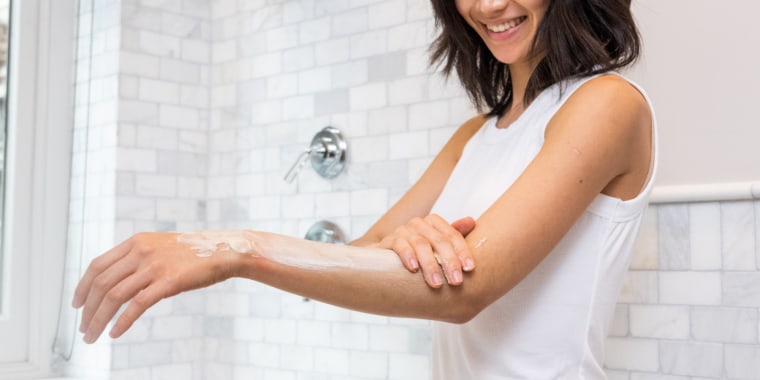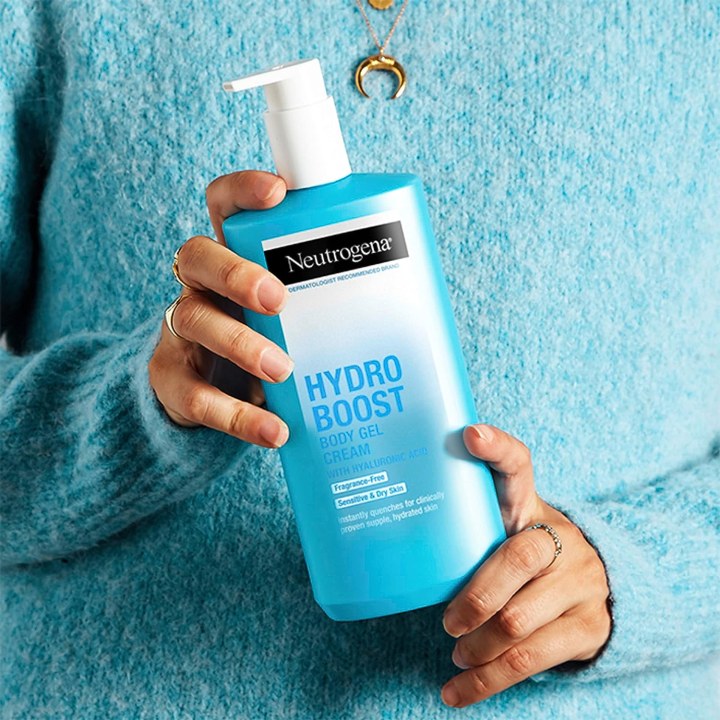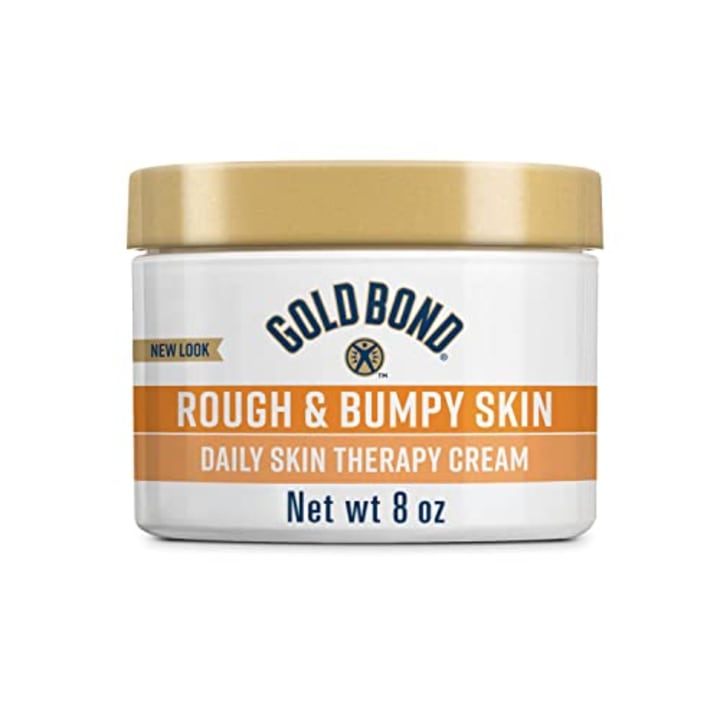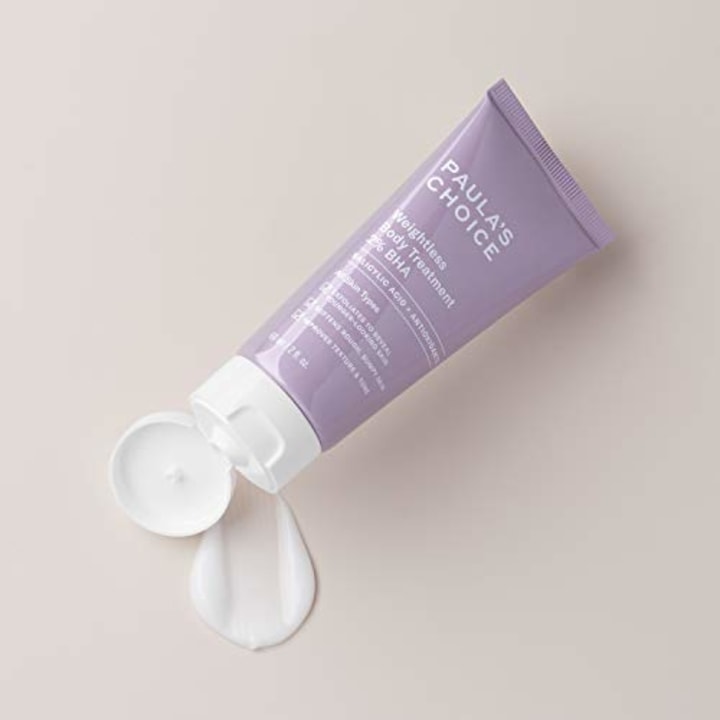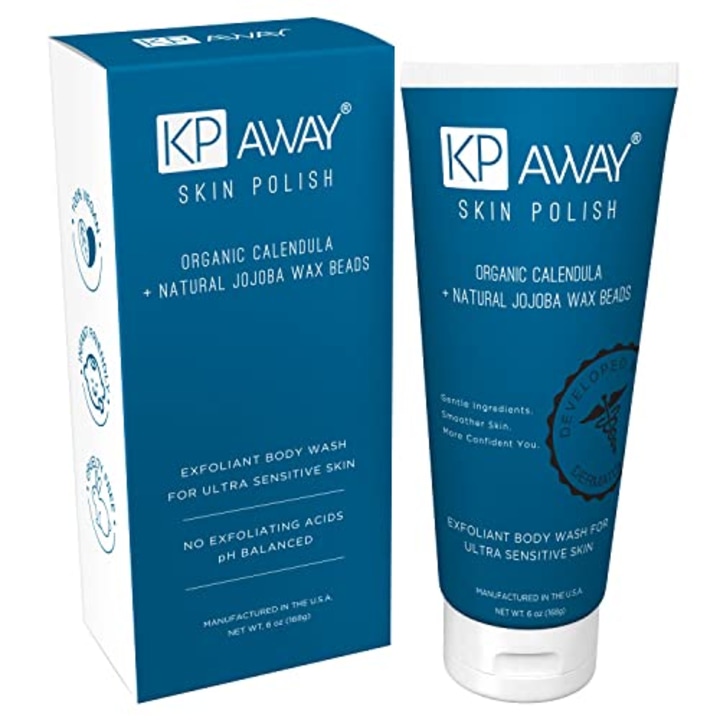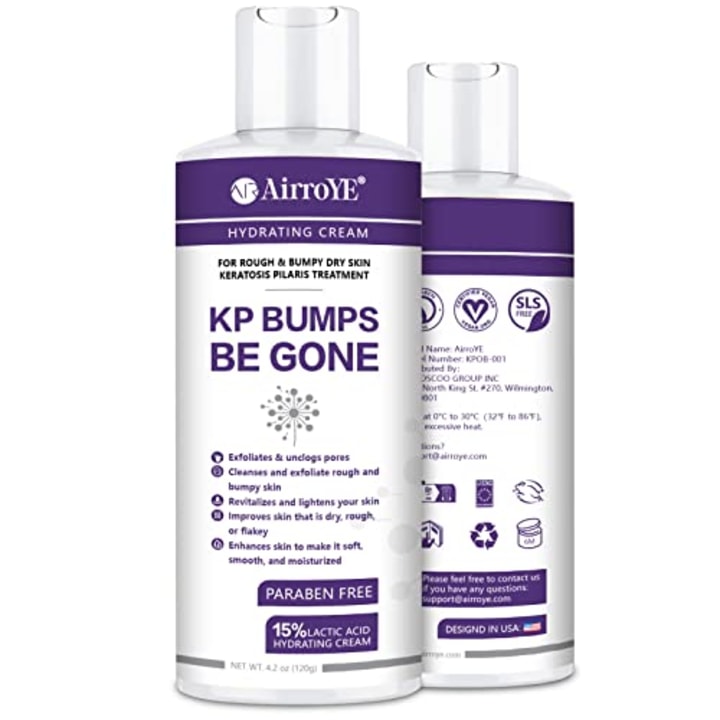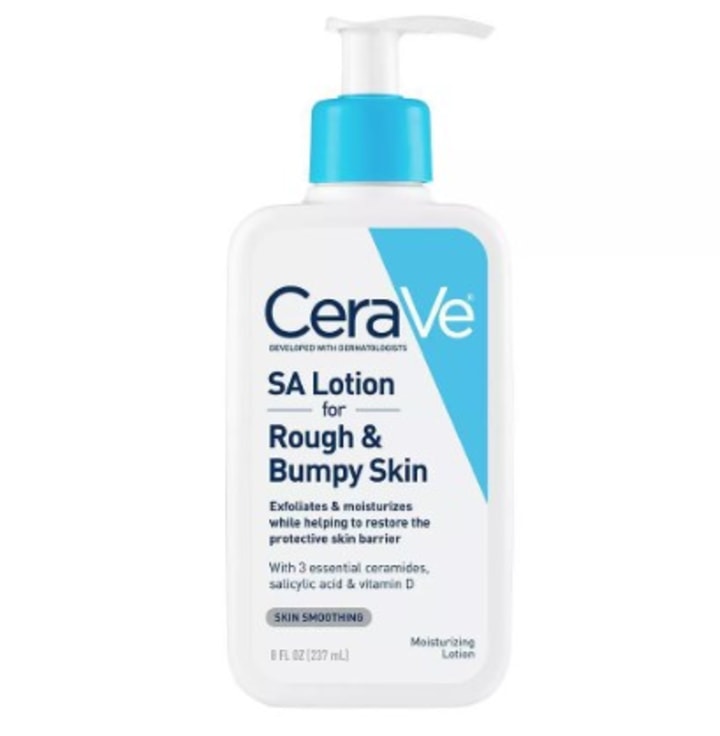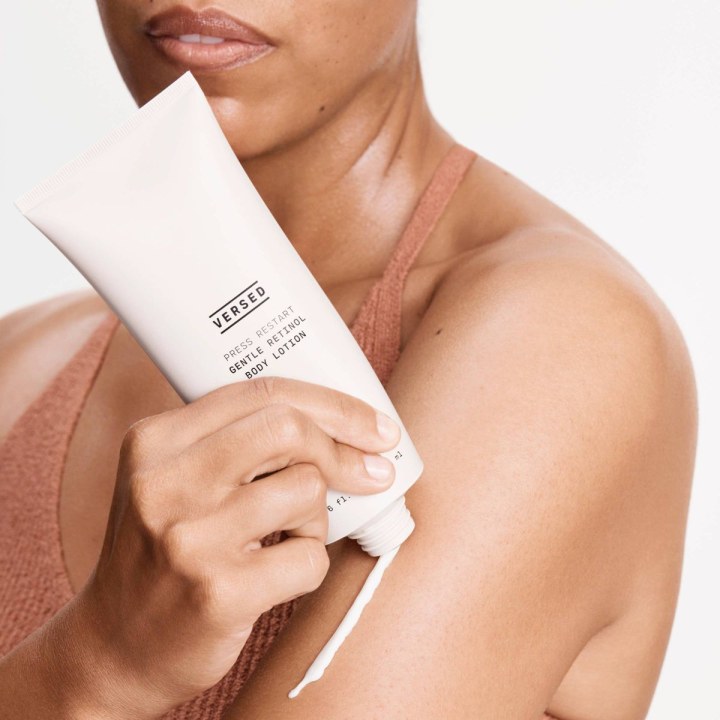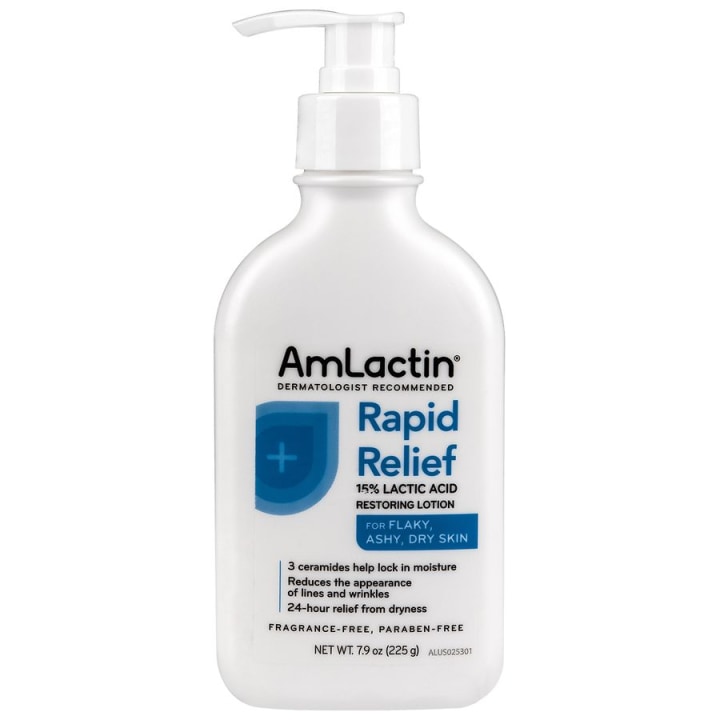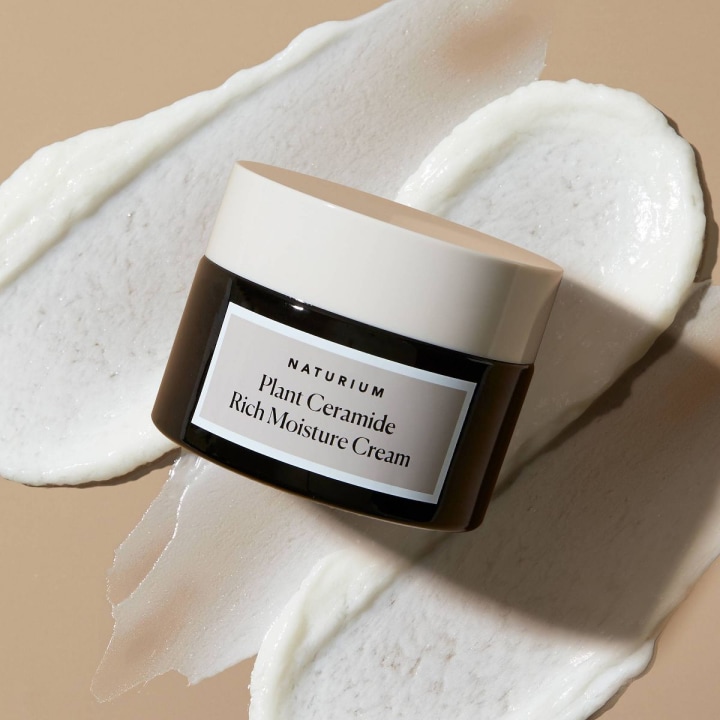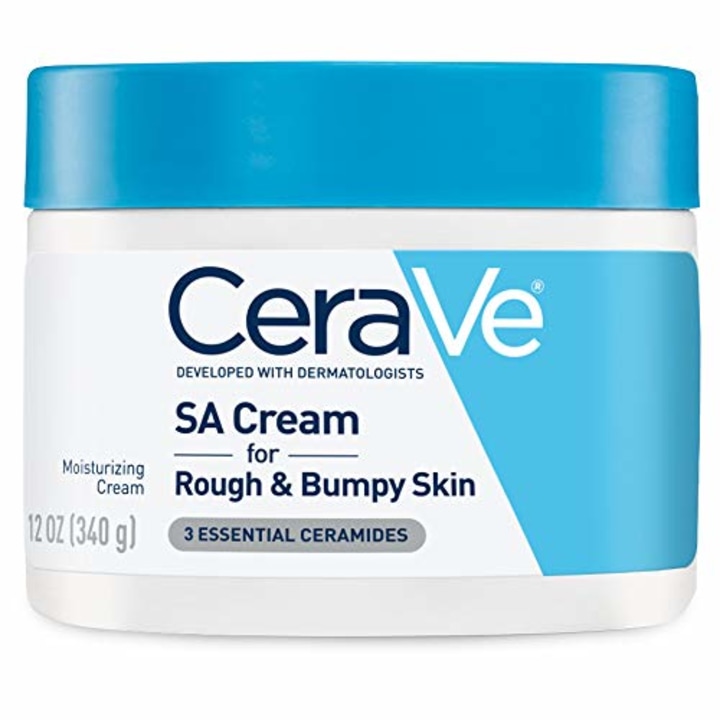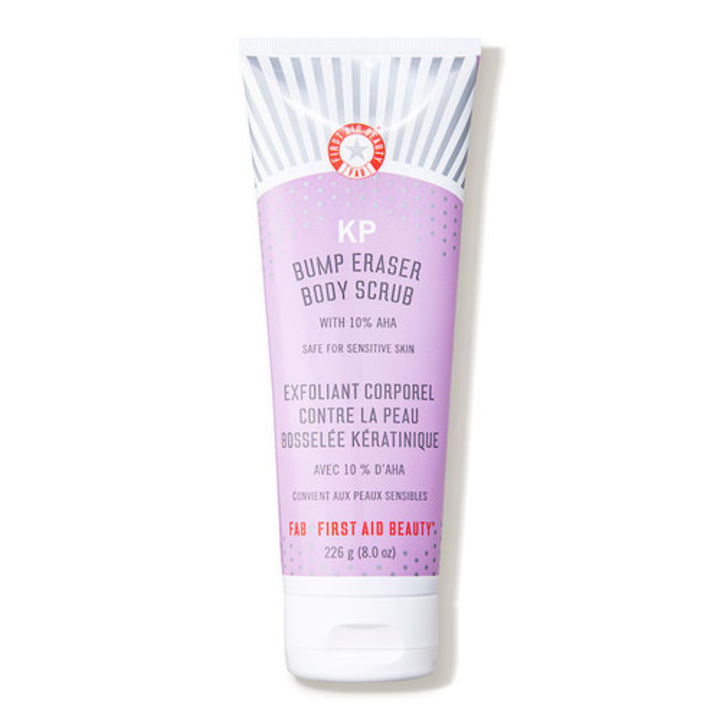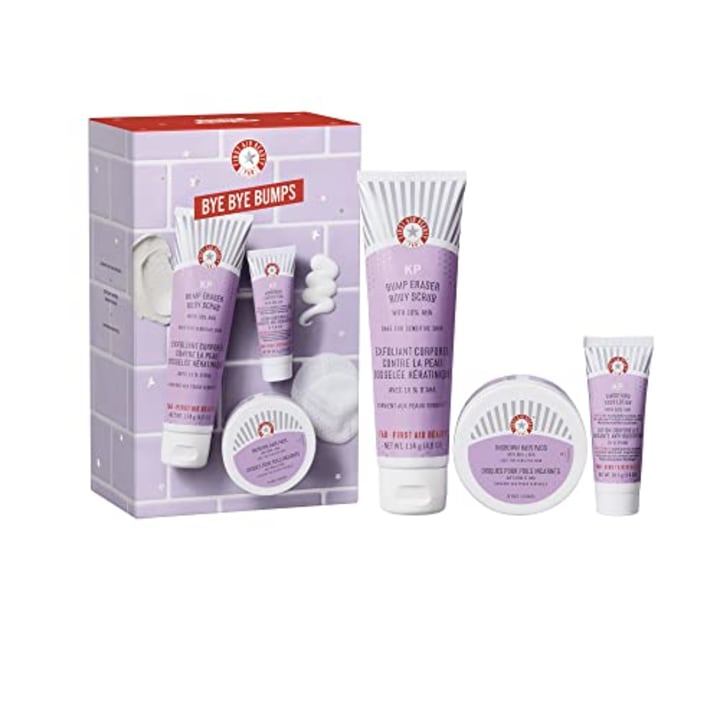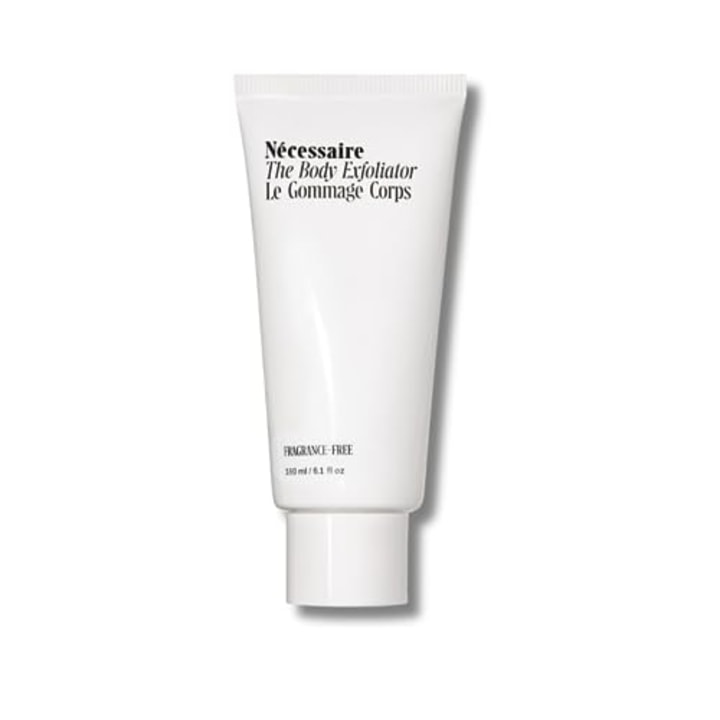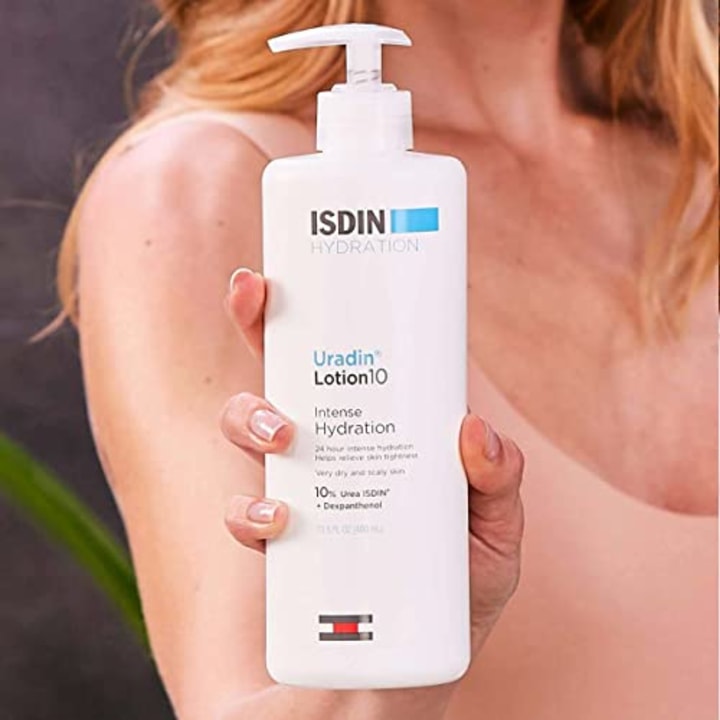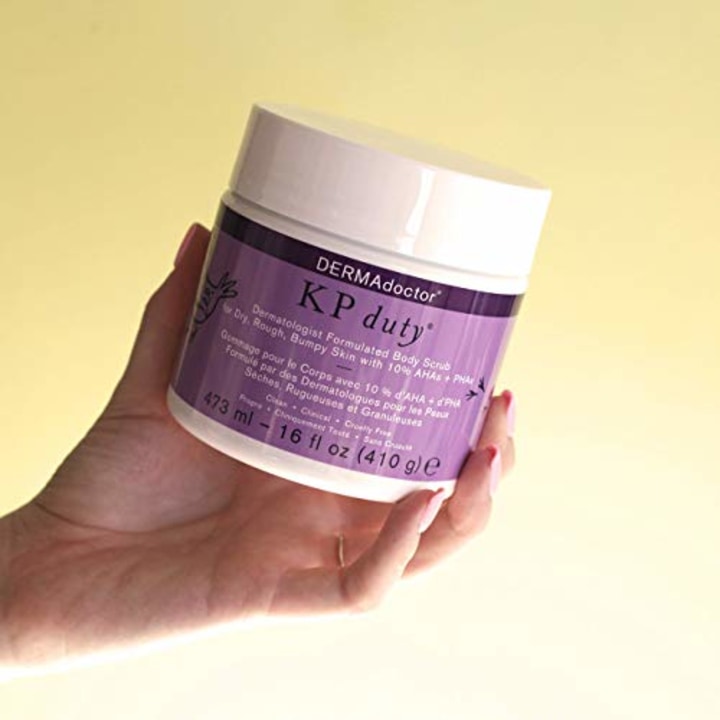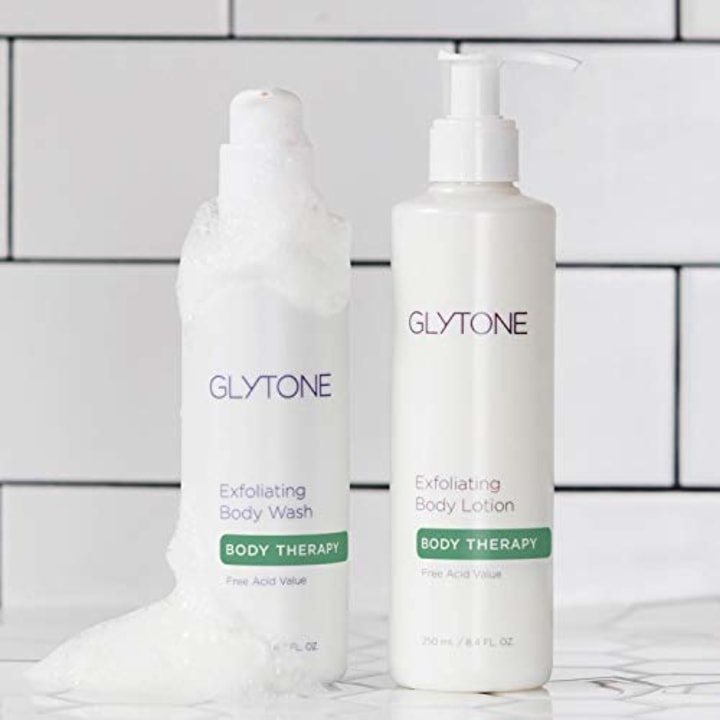Achieving clear skin from head to toe usually requires tackling more than one skin care concern — after all, the skin on your body often acts differently than the skin on your face.
For many, keratosis pilaris — or KP as many experts call it — is one of those issues that crops up on our body, resulting in “chicken skin.” “Keratosis pilaris is also known as rough and bumpy skin,” says board-certified dermatologist Dr. Corey L. Hartman. “It’s a dry skin marker that is associated with eczema and atopic dermatitis.”
Characterized by fine bumps and dry patches, this common condition has to do with a lack of moisturization, decreased exfoliation and a buildup of keratin inside the pores. This build up of keratin — which is a protein that protects skin — blocks the opening of hair follicles, creating tiny bumps.
Luckily, there are ways to both treat and prevent the condition from occurring. Here, we’ve rounded up the top products to keep your skin bump-free and some expert tips to help you navigate your KP journey.
Ingredients to look for | Expert picks | FAQs | Meet the experts
What ingredients should people look for in products for KP?
If you’re hoping to see progress fairly quickly, you’ll want to search for KP products that perform a few key tasks.
“Exfoliating and moisturizing are essential to controlling KP. Exfoliation removes dead cells from the skin’s surface — these skin cells are plugging the follicle and trapping keratin, which causes the bumps,” says board-certified dermatologist Dr. Blair Murphy-Rose.
She specifically recommends chemical exfoliation (as opposed to physical exfoliation) for KP. “Some options for chemical exfoliation include acid-containing topicals like lotions, cleansers or creams and chemical peels ranging from mild daily peels to stronger in-office monthly or biweekly peels."
Here are a few more effective ingredients the pros we polled swear by:
Exfoliators: Glycolic, lactic and salicylic acids, urea, retinol, ammonium lactate
- Moisturizers: Ceramides, hyaluronic acid, shea butter, petrolatum, dimethicone, glycerin
Best skin care products for keratosis pilaris, according to experts
Neutrogena Hydroboost Body Gel Cream
Size: 16 oz | Key ingredients: Hyaluronic acid, glycerin, dimethicone, petrolatum
This gentle hydrator from Neutrogena is one of Hartman's favorites. It utilizes hyaluronic acid to deeply hydrate the skin for long-term moisture retention. It’s also fragrance-free and non-greasy, making it ideal for those with sensitive skin.
Gold Bond Rough & Bumpy Skin Daily Skin Therapy Cream
Size: 8 oz | Key ingredients: Urea, shea butter extract, petrolatum, salicylic acid, dimethicone, jojoba esters, cocoa seed butter, panthenol
This bestseller is one of board-certified dermatologist Dr. Ranella Hirsch’s go-to products for KP and it’s easy to see why. The versatile formula is hypoallergenic and harnesses the power of seven moisturizers and three vitamins to leave skin feeling softer, smoother and less bumpy, according to the brand.
Paula’s Choice Weightless Body Treatment
Size: 2 oz | Key ingredients: Salicylic acid, chamomile, green tea, vitamin E, dimethicone
Dr. Liia Ramachandra, a former pharma executive and skin care expert, is a fan of this treatment for its strong yet gentle ingredient list. “I love it because it has salicylic acid and plant extracts. It has no allergens (such as parabens, fragrance etc.) and it is super lightweight yet exfoliates and softens rough skin,” she tells us.
KP Away Skin Polish
Size: 6 oz | Key ingredients: Glycerin, vitamin E, jojoba seed oil, organic aloe leaf juice
Another one of Hirsch's picks and an Allure Best of Beauty winner in 2022, this body polish offers acid-free physical exfoliation with the help of jojoba oil wax beads. They start by exfoliating then go on to nourish skin.
AirroYE KP Bumps Be Gone
Size: 4 oz | Key ingredients: Salicylic acid, lactic acid, citric acid, glycerin
“This body cream is very moisturizing and has a lot of great active ingredients. Salicylic acid, lactic acid, citric acid and glycerin do the 'heavy lifting' and moisturize and smooth skin,” Ramachandra says.
Per the brand, this lotion boasts a lightweight formula and also works for a range of other skin care concerns, including stretch marks, razor bumps, dark spots and fine lines.
CeraVe SA Lotion for Rough & Bumpy Skin
Size: 8 fl oz | Key ingredients: Ceramides, salicylic acid, vitamin D, hyaluronic acid, lactic acid, glycerin, dimethicone, niacinamide
CeraVe’s SA renewing formula also comes in a lotion format and Dr. Angela J. Lamb, a board-certified dermatologist in New York City, is quite fond of it. “It’s easy to find at most drugstores and contains salicylic acid in a rich, emollient base,” she says.
Board-certified dermatologist Dr. Margarita Lolis also notes that the lotion contains niacinamide, a potent antioxidant.
“It helps calm the irritation and redness which can result from KP itself and from exfoliating. The ceramides in this product strengthen the skin barrier and glycerin draws in moisture and seals it in providing long-lasting hydration,” she says.
Versed Press Restart Gentle Retinol Body Lotion
Size: 6 fl oz | Key ingredients: Retinol, cocoa butter, squalane, vitamin E
A callout from Kiran Mian, a medical and aesthetic dermatologist at Hudson Dermatology and Laser Surgery, this lightweight lotion quickly goes to work to smooth and firm skin, tackle breakouts and moisturize.
“It has retinol, which is encapsulated to prevent irritation as well as squalane and cocoa butter to replenish moisture,” she tells us.
AmLactin Rapid Relief Restoring Lotion
Size: 7.9 oz | Key ingredients: Lactic acid, glycerin, dimethicone, ceramides
AmLactin offers a Rapid Relief version of their ever-popular moisturizing body lotion that Mian recommends.
“Amlactin has alpha hydroxy acids that help clear off the top layer of dead skin cells. Glycolic acid and lactic acid are also humectants and help skin hold on to water, making them excellent ingredients in moisturizers,” Mian says.
Naturium Plant Ceramide Rich Moisture Cream
Size: 1.7 oz | Key ingredients: Ceramides, glycerin, shea butter, rosemary leaf extract
Ramachandra also loves this non-greasy ceramide cream that’s made with a mix of botanical-, earth- and marine-based ingredients.
“It provides the needed moisture and hydration for keratosis pilaris. The cream is cruelty-free, paraben-free, vegan, gluten-free, fragrance-free and non-toxic,” she raves.
CeraVe SA Cream for Rough & Bumpy Skin
Size: 12 oz | Key ingredients: Ceramides, salicylic acid, glycerin, niacinamide, hyaluronic acid, dimethicone
Formulated with salicylic acid, this CeraVe cream is also recommended by Hartman due to its exfoliating formula. Not only does the salicylic acid buff away dead skin cells, but the ceramides in the formula deeply hydrate the skin for a nourished feeling post-application.
First Aid Beauty KP Bump Eraser Body Scrub
Size: 8 oz | Key ingredients: Glycolic acid, lactic acid, glycerin, licorice root extract, bisabolol, vitamin E
Both physical and chemical exfoliants are used in this body scrub to erase signs of keratosis pilaris — fast. To combat any irritation from all that extra exfoliation, this product also contains bisabolol for a calming effect and vitamin E for hydration.
“It contains two types of alpha hydroxy acids (lactic and glycolic acid) as well as pumice buffing beads, which mechanically remove dead skin cells,” Lolis tells us.
First Aid Beauty Bye Bye Bumps Kit
Sizes: 4 oz, 1 oz, 28 pads | Key ingredients: Glycolic acid, lactic acid, salicylic acid, dimethicone, glycerin, licorice root extract, bisabolol, urea, colloidal oatmeal, ceramides
Want to really step up your efforts to tackle KP? First Aid Beauty also offers a value set that contains its popular KP Bump Eraser Body Scrub, KP Smoothing Body Lotion and Ingrown Hair Pads.
“I love this kit because it has products that address all of the aspects that impact keratosis pilaris. It exfoliates, moisturizes and addresses ingrown hairs,” Lamb tells us.
Nécessaire The Body Exfoliator
Size: 6.1 fl oz | Key ingredients: Glycolic acid, salicylic acid, lactic acid, glycerin bamboo charcoal
Board-certified dermatologist Dr. Robert Anolik calls out this exfoliator and says it "may be helpful for some people who develop hyperpigmentation associated with the KP." Meant to be used just once weekly — like during your everything shower — it's suitable for all skin types.
Isdin Uradin Lotion10
Size: 13.5 fl oz | Key ingredients: Urea, panthenol, glycerin, dimethicone, lactic acid
Lolis is a fan of this lotion from Isdin. “It contains 10% urea but also contains emollients, which restore hydration for up to 24 hours. This relieves any dryness or itchiness, which is commonly associated with KP,” the expert tells us.
Plus, according to the brand, the fast-absorbing formula is lightweight and won’t leave skin feeling greasy.
Dermadoctor KP Duty Dermatologist Formulated Body Scrub
Size: 16 oz | Key ingredients: Lactic acid, glycolic acid, glycerin
“Keratosis pilaris is very common and it’s not considered harmful, so while treatment is not required, some people wish to treat it,” board-certified dermatologist Dr. Marisa Garshick says.
Combining the benefits of a chemical peel and microdermabrasion into one product, this formula uses both glycolic acid and lactic acid to deeply penetrate the pores and clear out the skin for a softer feel.
Glytone KP Kit
Size: 6.7 and 8.4 fl oz | Key ingredients: Glycolic acid
“Keratosis pilaris involves skin that is underhydrated, under moisturized and under exfoliated, so treatment should address all three,” says Hartman. “ Moisturization is achieved with emollients and heavy creams containing ceramides to replenish the skin barrier. Exfoliation is achieved through hydroxy acids like glycolic and salicylic acid.”
This kit by Glytone is a favorite of Hartman’s since it includes a glycolic acid-based body wash and a lotion to tackle all the symptoms of KP at once.
Frequently asked questions
Which skin types most commonly have KP? How common is KP?
Some skin types are naturally more prone to certain skin conditions, but KP in particular can affect just about anyone.
“Keratosis is a very common skin condition. It has been estimated that almost 50% of people will experience some form of keratosis pilaris in their lifetime,” board-certified dermatologist Dr. Brendan Camp says.
Per Murphy-Rose, all skin types can develop KP, but it’s more common if you have dry skin.
“It has been associated with dry skin, eczema and vitamin A deficiency. KP is incredibly common and runs in families,” she tells us.
What triggers KP?
The condition itself is caused by abnormal shedding of skin cells, according to Murphy-Rose.
“Dead skin cells build up around hair follicles, plugging the follicles and trapping keratin. People with KP have skin cells that adhere longer than normal to the underlying skin cells around the hair follicles. This leads to the plug that traps the whitish keratin below,” she says.
Of course, KP can be triggered at certain times more than others.
“Keratosis pilaris can be exacerbated by dry skin. Common causes of dry skin include long showers, multiple showers, using hot water in a shower or bath, not using a moisturizer after a bath or shower and using soaps that strip skin of oils that normally help to trap moisture in the skin,” Camp explains. “Environmental factors that can worsen KP include cold temperatures and a lack of humidity.”
Garshick adds hormonal changes — such as pregnancy — to the list of potential triggers.
How long does it usually take to see improvement?
KP can be pretty stubborn, but with regular treatment twice a day, you can typically expect to see improvement within one month, according to Murphy-Rose.
“While the skin may feel softer and smoother immediately after exfoliation, it may take weeks to months to see consistent improvement,” Garshick adds.
Per Camp, the “chronic condition” has no cure and consistent treatment is necessary.
“In order for treatments to be effective, they need to be used on a regular basis over an extended period of time. While some people with mild cases of KP may notice an improvement after just a few weeks, others may need to continue treatment for a few months before noticing changes,” the pro says.
What should people avoid doing or using (product types and/or ingredients) if they have KP?
Now that we’ve gone over what to do to treat KP, let’s take a moment to explain what not to do if you’re hoping to avoid exacerbating the situation. Here’s a quick cheat sheet from the experts:
Mechanical exfoliators (harsh scrubs and loofahs): “These irritate and inflame skin, leading to worsening KP,” Murphy-Rose says.
Anything that’ll dry out your skin: “Keeping showers short, showering only once a day, using gentle cleansers and showering with lukewarm or tepid water are tips to help maintain the skin’s natural oils, which normally function to trap water in the skin,” Camp says.
Meet the experts
Dr. Corey L. Hartman, MD, is a board-certified dermatologist and founder and medical director of Skin Wellness Dermatology in Birmingham, Alabama. He also serves as Assistant Clinical Professor of Dermatology at the University of Alabama School of Medicine. He has previously shared his expertise on body lotions with SPF, vitamin C serums and activated charcoal in skin care.
Dr. Blair Murphy-Rose, MD, FAAD, is a board-certified cosmetic and medical dermatologist in New York and clinical instructor of dermatology at Weill Cornell. She currently practices at Laser & Skin Surgery Center of New York.
Dr. Ranella Hirsch, MD, FAAD, is a board-certified dermatologist based in Boston. Her specialties include laser surgery and cosmetic dermatology, often lecturing physicians on those topics. She has previously spoken with us about how to repair your skin barrier, how to care for your scalp and retinol serums.
Dr. Liia Ramachandra, Pharm.D., Ph.D, is a former pharma executive and skin care expert based in Canoga Park, California. She is the CEO and founder of skin care brand Epilynx. She has previously shared her expertise on retinol serums, body oils and thinning hair.
Dr. Angela J. Lamb, MD, is a board-certified dermatologist in New York City. She has previously spoken with us about thinning hair, retinol serums and seasonal hair loss.
Dr. Margarita Lolis, MD, is a board-certified dermatologist, practicing at Skin Laser and Surgery Specialists in New York City. She is also fellowship-trained and a Mohs surgeon.
Dr. Kiran Mian, DO, FAAD, is a board-certified dermatologist at Hudson Dermatology and Laser Surgery in New York City.
Dr. Robert Anolik, MD is a board-certified dermatologist and a fellow of the American Academy of Dermatology. He specializes in cosmetic dermatology and laser skin surgery. He has previously spoken with us about retinol serums, facial redness and SPF mistakes.
Dr. Marisa Garshick, MD, FAAD, is a board-certified dermatologist for MDCS Dermatology: Medical Dermatology & Cosmetic Surgery. She serves patients in Manhattan, New York, and Clifton, New Jersey. She has previously shared her expertise on hydrating skin care, gold in skin care products and The Ordinary products.
Dr. Brendan Camp, MD, is double board-certified in dermatology and dermatopathology. He currently practices at MDCS Dermatology: Medical Dermatology & Cosmetic Surgery which has several locations around New York.
